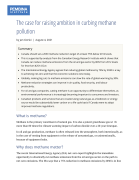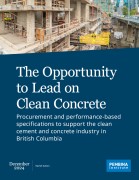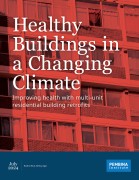While the “what” of Canada's commitment to net-zero carbon emissions by 2050 is seemingly simple, the “how” is much more complex. Infinite scenarios are compatible with reaching net-zero, but not all are compatible with keeping global temperature rise below 1.5 degrees Celsius and delivering a more inclusive, resilient, and competitive economy.
If Canada is to succeed in reaching climate targets, pathways to net-zero emissions must be rooted in the principle of putting people first and prioritizing systemic change that results in an economy that works for all Canadians. Because more emissions now means more warming later, some pathways are much riskier than others. To address the reality that not all pathways are created equal, pathways to net-zero should also be guided by these essential principles:
- Pathways to net-zero must be anchored in science and respect a carbon budget;
- Pathways must prioritize early, deep, sustained, technologically feasible reductions in every sector;
- Pathways must define an appropriate role for carbon removal and offsets.
In this report, the Pembina Institute also documents key steps to take, and tools to utilize, to bring these principles to life. Key steps include setting ambitious, national and sectoral targets and budgets for each five-year milestone period from 2025 to 2050, separating emissions reduction from carbon removal targets, articulating plans to act on all available direct emissions reduction opportunities for each sector for each milestone period, and implementing policies that incentivize research and mobilize capital to make direct emissions reductions possible for future five-year targets. Tools include the United Nations Declaration on the Rights of Indigenous Peoples, an accurate definition of net-zero in Canada’s Strategic Assessment of Climate Change, offset systems and compliance mechanisms, and more.
Principles guiding robust pathways to net-zero
- Canada’s pathways to net-zero must put people first, prioritizing systemic change in the economy for the benefit of all. Realizing the potential of the 2050 commitment requires a greater focus on social justice and inclusion achieved through conversations with Canadians in Indigenous communities, the private sector, workers and trade unions, local and racialized communities, as well as with youth, new Canadians, women and economically vulnerable populations. This will ensure that Canada’s net-zero pathways respect Indigenous rights and reconciliation. It will also enable broader understanding of risks faced by different groups in the transition to a net-zero economy and how targeted policies can be developed to avoid disproportionate impacts and create an economy that works for every Canadian.
- Canada’s pathways must be anchored in science and respect a carbon budget. While the net-zero by 2050 target speaks to the destination, the 1.5-degree goal speaks to the journey. There are infinite scenarios compatible with reaching net-zero emissions, but not all are compatible with keeping global temperature rise safely below 1.5 degrees Celsius. The real measure of success of a net-zero pathway is whether it keeps cumulative emissions to a level that is in line with this 1.5-degree goal. A carbon budget — the amount of emissions that can enter the atmosphere if we wish to limit warming to 1.5 degrees Celsius — is a key tool to ensure safe pathways.
- Canada’s pathways must prioritize early, deep, sustained, and technologically feasible direct emissions reductions in every sector. Robust pathways to net-zero must see emissions peak as soon as possible, decline rapidly thereafter and reach a balance of human-caused (anthropogenic) sources and sinks. Delay leads to higher atmospheric carbon concentrations and higher temperatures, producing increasingly costly economic damages from climate change, and requiring more aggressive and likely costlier action later to limit even higher levels of atmospheric carbon. Moving boldly can secure Canada a spot at the starting line of the race to a low-carbon, global economy.
- Canada’s pathways must define an appropriate role for carbon removal and offsets. Achieving net-zero will require the use of carbon removal to address hard-to-decarbonize sectors or essential end uses that cannot yet be decarbonized. Carbon removal and offsets, however, cannot be approached as an alternative to mitigation, but rather in addition. Given the high cost, long lead time and other potential limitations on development of carbon removal technologies, Canada needs a framework in which decisions about the development and prioritization of use of removal technologies can be made in the context of overall economic decarbonization. Further, breaking down net-zero targets into three parts — direct reduction, carbon removal, and emissions neutralized through offsets — can help create transparency and robustness in a mitigation portfolio.
Safe versus dangerous pathways to net-zero emissions by 2050
Scenario 1 (red) achieves net-zero but fails to safely limit temperature rise because it does not use a carbon budget and delays emissions reductions, resulting in a much greater release of total emissions into the atmosphere in the same time period. Scenario 2 (blue) uses early, deep, and sustained emissions reductions in adherence with a climate budget to achieve emissions mitigation required to limit global temperature rise to 1.5 degrees Celsius.








